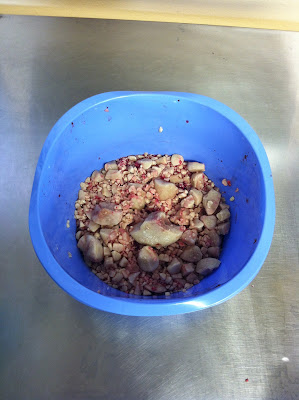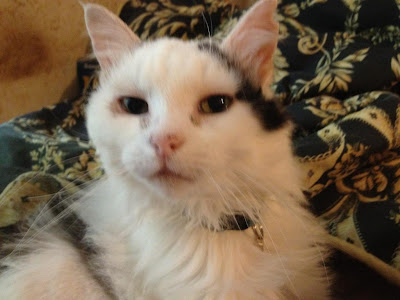 |
| Prepping a patient (Harley) for a cystotomy. |
Today's question on Pawbly (http://www.pawbly.com/) was a good reminder of why an open ongoing dialogue with your vet is so important.
I also was curious why this person was so adverse to a prescription diet? (The limitation of a one-way dialogue via email is that I can't ask question, I love to ask questions,,we will work on the chat version of this service as our next evolution to this service). I think that there is some adverse feelings towards prescription diets and I know they are expensive. I wanted to share this question and answer in my blog and I wanted to discuss another JVC patient with a similar history.
Here is the Pawbly question;
I have a Bichon Frise who recently (last Thanksgiving) had 62 stones removed. She recoved nicely but her pH is still high. She is eating raw (Nature Variety). I put in Berry Balance in her food as well as Ammonil DL-Methionine Tablets), Biotic pH and Milk Thistle. Her pH did look like it came down a bit and she doesn't seem to be in pain as much. Is there anything else that I can feed her without going to prescription dog food (Science Diet).
Here is my answer;
Hello and
Thanks for your question.
Unfortunately I would need more information to be able to specifically advice you on what to do.
First, I don't know what kind of stones were in your dogs bladder?. (Note, 62!!! I have retrieved a whole mess of stones, but to be truthful I never counted them).
I think that you feel that you need to alter the pH to reduce the likelihood of the stones forming, but it isn't as simple as that in many cases. The pH does influence the ability of stones to form but there are other factors also.
So I am going to go out on a limb and presume that your dog had struvite stones?
Struvite stones are formed because of infection, and NOT pH. So, the task to prevent the stones is to treat and prevent the infection. OK, here's where is gets a little tricky. The urine may consistently stay high because of the UTI (urinary tract infection), the bugs that are the infection are urease producing organisms. These urease producing bugs are usually Staph, it is the infection that causes the struvite and the infection changes the pH. So, the way to get rid of your high pH and your stones is to get rid of your infection..I know one vet who says "if you get consistently high pH you get your pet in the vet."
Most bacteria are happy critters at a pH of between 4-9, and dogs and cats can't acidify their urine below 5.5 so you can't ever acidify the urine low enough to prevent a UTI.
Also the experts advice is to make sure that you are checking the urine frequently throughout the day and using a pH monitor (not a urine stick), these can be found at any home or garden store, they are the monitors people use for testing their water. (It will be a little expensive but it is accurate..) Also, if it is struvite you might be able to dissolve the stones and therefore avoid another surgery.
I am not an advocate for adding things to the diet. I don't think it will help your current situation and I have unfortunately seen too many very well intentioned people make a bigger problem than they started with.
To identify IF and what kind of infection your dog might have you will need a culture and sensitivity done. Your veterinarian will take a sterile sample of urine from your dogs bladder and submit it to the laboratory for them to grow on a culture. They can then specifically identify what type of bug is present and also exactly which antibiotic to use to kill them.
I will tell you that in my experience the little white dogs seem to have the most problems with urinary stones..and I think that the prescription diets work very well, and adding lots of water to their food and encouraging water intake with a fountain or soupy food helps.
IF, your dog didn't have struvite then you would need to talk to your vet about a treatment plan for the specific stone. I do not think that it is question of pH in almost all cases. And some stones can only be resolved by surgery.
I hope that this helps, and I hope that your dog stays happy and healthy,
If you need any assistance from us you can find me at Jarrettsville Veterinary Center, we have an ultrasound and we could take a peek at your dogs bladder to get a sterile sample and see if any stones are floating around.
Sincerely,
Krista
Krista
Not to long ago I was asked by one of the groomers if I could help her mother in laws dog who she had noticed was having bloody urine. She was pet sitting for their dog because her mother in law was in the hospital recovering from a serious illness. Turned out that she had 2 patients on her hands, one was recovering in the hospital and one was coming to visit ours. When she brought in Harley we were all amazed to learn that she had been hematuric (blood in the urine) for a very long time. As soon as the vet on duty palpated her belly we knew the source of her blood. She had a two fist sized sand filled sac of a bladder. It was very easily palpable and within minutes every set of hands in the building were on Harley. An x-ray put a digital picture to what we could already surmise. The next stop was asking me if I would extract them.
 |
| Removing stones from the bladder. |
 |
| That's a big stone! |
The next week Harley had her cystotomy (bladder surgery).
Harley and her mom are both recovering well and we will continue to monitor Harley any signs of a return of her stones, or a change in pH, urine color, urine frequency, and at least twice yearly urinalysis.
 |
| The final stone tally. A bucketful! |
Urinary calculi (stone) should be submitted for a calculi analysis. This is imperative in the treatment plan and prevention of future stones.




































